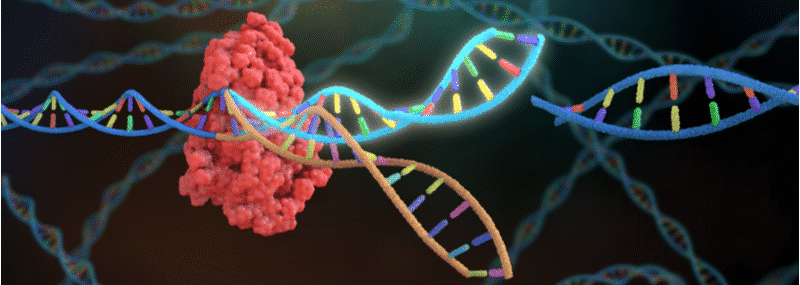A Q&A with Fady Riad, CEO of consulting company Centurion Life Sciences.
How did CRISPR/Cas9 revolutionize gene editing and the broader life sciences industry?
CRISPR/Cas9 is undoubtedly one of the greatest scientific advancements of the last 100 years.
In 2012, Jennifer Doudna and Emanuelle Charpentier published a peer-reviewed paper discussing the use of CRISPR/Cas9 in gene editing. They probably didn’t know it back then, but they had just democratized gene editing and changed biotechnology for years to come.
CRISPR is not only easier to use when compared to alternative gene editing methods such as meganucleases, zinc finger nucleases (ZFNs), and transcription activator-like effector-based nucleases (TALENs), but is also cheaper and offers a faster turnaround time.
As we’ve seen with numerous molecular biology tools, the cost tends to go down significantly with time, and CRISPR is no exception – and I expect this trend to go on.
Doudna and Charpentier’s paper led to exponential interest from academia in the novel technology. In fact, the number of yearly publications on CRISPR/Cas9 grew over 1000-fold over the last 10 years.
In 2020, both Doudna and Charpentier won the Nobel Prize in Chemistry for their discovery of the genetic scissors. This, coupled with extensive media coverage, has made generalist and specialist investors alike very interested in CRISPR/Cas9 applications – especially in the realm of therapeutics.
How is CRISPR/Cas9 going to impact existing treatment modalities?
Perhaps one of the most interesting applications of CRISPR/Cas9 in CAR T-cell therapy.
CAR T-cell therapy is another innovation that is disrupting healthcare. The transition from managing symptoms to curing disease is truly personified by immunotherapy, and as a result cancer patients are having better outlooks both in terms of quality of life and survival.
We are at the dawn of CAR T-cell therapy and as promising as this treatment modality is, it does not yet come without drawbacks such as off-tumor effects and other toxicities, lack of CAR T-cell persistence, and long turn-around times. CRISPR can help manufacturers deal with these issues and significantly impact clinical outcomes.
With time, the more precise CRISPR/Cas9 will displace older gene editing techniques that are currently used by CAR T-cell therapy manufacturers – which will lead to safer and more effective treatments.
Allogeneic CAR T-cell therapy is one of the most promising areas of research in the industry.
These “off the shelf” CAR T-cell therapies have significant advantages in terms of cost and turn-around time over their autologous counterparts. CRISPR/Cas9 can and will play a crucial role in the development of allogeneic CAR T-cell therapies.
Strategic partnerships between CAR T-cell therapy manufacturers and biotechs with robust CRISPR/Cas9 platforms are matches made in heaven that bring tremendous values to patients and shareholders. I suspect we will see more of these alliances in the coming years as CAR T-cell therapy matures.
What does the future look like for CRISPR/Cas9-based therapeutics?
Vertex Pharmaceuticals and CRISPR Therapeutics’ exagamglogene autotemcel potential sickle cell disease and beta thalassemia curative therapy could very well be the first CRISPR/Cas9-based therapeutic to hit the markets if approved by the FDA. But Vertex and CRISPR Therapeutics are far from being the only significant players in this space. Intellia Therapeutics and Editas Medicines – to only name a few – are companies with very interesting CRISPR/Cas9 platforms.
Exagamglogene autotemcel is an ex vivo therapy, which means that the cells are edited outside of the patient’s body – this of course comes with its own drawbacks in terms of cost and logistics. The next frontier in CRISPR/Cas9 is the development of in vivo gene editing therapies.
The potential of CRISPR/Cas9 gene editing in curing monogenic disease is being clearly established, but the next stage of the CRISPR/Cas9 saga is targeting polygenic disease.

Over 98% of genetic diseases are polygenic in nature – a fact that is making investors very excited.
And last but not least, novel drug delivery systems – more specifically nanolipids – have the potential to revolutionize both the safety profile of CRISPR/Cas9 therapeutics as well as the scope of conditions being targeted.
What are the main challenges of CRISPR/Cas9?
The regulatory and legislative landscape has not fully matured yet and this is obviously impacting clinical development – this is all but surprising given the novelty of CRISPR/Cas9.
Scalability in terms of manufacturing is another hurdle that will be overcome with time.
The main concern with CRISPR/Cas9-based therapeutics is obviously the high probability of off-target effects – which is something that can potentially deter physicians and investors alike. But the issue is more nuanced than that. Healthcare professionals know very well that every treatment decision is to an extent a trade-off between efficacy and safety – and CRISPR/Cas9 therapeutics should not be an exception. In other words, based on the risk-benefit ratio, what is adequate for a specific patient profile might not be adequate to all patients.
The viability of CRISPR/Cas9 therapeutics for common conditions – as opposed to rare diseases, cancers and blood conditions – is an area of speculation that will most definitely be determined by the improvements in the safety profile of these therapeutics. What a patient with limited therapeutic options can tolerate is very different to what a patient with a common condition can.
Another factor that is impacting the viability of CRISPR/Cas9 therapeutics for common conditions is the ability to penetrate the CNS and other tissues such as muscles. This is where novel delivery systems come into play.
What is the potential for CRISPR/Cas9 beyond therapeutics?
I don’t know if saying that therapeutics are only the tip of the iceberg would be accurate, but there is clearly a sea of opportunities. I firmly believe that in the coming years CRISPR/Cas9 will play a pivotal role in most – if not all – stages of drug discovery and development.
One other area where CRISPR/Cas9 can bring a lot of value is diagnostics. Nucleic acids that are present as a result of either infections or malignancies can be accurately and cost-effectively detected by CRISPR/Cas9-based diagnostic tools.
Drug resistance, cosmetics and the gut microbiome are other areas where CRISPR/Cas9 has potential to bring a lot of value.
Beyond healthcare, agriculture is a space where CRISPR/Cas9 can be a game changer by taking productivity to levels unheard of and significantly expanding the agricultural market.
Fady Riad is the CEO of Centurion Life Sciences, a consulting firm that helps hedge funds, private equity firms and other institutional investors better understand the pharmaceutical industry landscape in order to make informed decisions.





